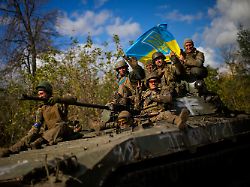Russia is massively expanding the defense lines in Ukraine. But do the invaders have enough soldiers and material to man them sufficiently? Calculations show that this is virtually impossible over the entire length of the front.
The Moscow military leadership knows that one or more Ukrainian offensives are imminent and has been trying to prepare for it for months, building and strengthening defense lines along the entire front line. They are made up of trenches and fortifications that extend over several zones and sometimes tens of kilometers in depth. But the invaders can probably hardly or only very sparsely occupy them. If they don’t know exactly where Ukraine is striking, they stand little chance of repelling the attack, experts suspect.
The former Finnish officer and OSINTanalyst Pasi Paroinen in a lengthy Twitter thread. Using an example in the Zaporizhia Oblast, he shows that the facilities extend over several sections from the front 25 to 30 kilometers into the rear.
The first zone is three to four kilometers behind the front line and consists of individual outposts and bases. This is followed by a first closed line of defense two to three kilometers deep. Like other lines, it is based on dominant heights and ridge lines. It consists of trenches and bases.
Zone 3, with reserve troops and possible decoy positions, is four to five kilometers deep. According to Paroinen, the majority of Russian artillery is located there, as well as mechanized reserves with shelters for vehicles and equipment.
City as the last fortress
Zone 4 is the main line of defense. It consists of several layers of heavily constructed trenches, anti-tank ditches and concrete “dragon teeth”. There are probably minefields too. These fortifications, three to four kilometers deep, formed a nearly continuous belt of defenses along the front, writes Paroinen.
A zone of retreat and reserve positions follows. In this example, the sixth zone is the city of Tokmak, which has a population of 23,000 and is surrounded by a moat and bases.
These are impressive defenses, but they also need to be garrisoned, which seems nearly impossible for Russian troops. Former officer in the Italian Alpini General Command, Thomas C. Theiner, uses a NATO handbook to explain why.
300 men per kilometer needed for the first line alone
In an even fight against mechanized divisions and armored divisions, 300 men per kilometer would be needed in the first trench line alone, he estimates. That’s 9,000 soldiers for a 30-kilometer front section. According to Theiner, 600 main battle tanks, 900 infantry fighting vehicles and another 22,000 men should be positioned behind them. He estimates the equipment of the 31,000 soldiers to be 180 Spike anti-tank guided missiles, 900 Panzerfaust 3 and more than 240 81 and 120 millimeter mortars.
According to Theiner, 240 or more 155mm howitzers and two medium-range and short-range air defense battalions are needed to support these troops. “A total of 54,000 men were to be deployed to hold 30 km of front line, with an additional 36,000 men in reserve should the enemy be able to break out.”
On top of that. According to Theiner, this reserve needs 400 main battle tanks, 600 infantry fighting vehicles and 180 155 mm howitzers. “A total of 90,000 soldiers are needed to defend a 30 km front against a peer enemy using eight to ten armored and motorized rifle divisions for a major offensive,” said Theiner. “But overall the front is around 800 kilometers long. And Ukraine is about to deploy the equivalent of six to eight divisions to attack at just one point on that line, and the Russians don’t know where.” In NATO, a division consists of 10,000 to 20,000 soldiers.
Russia has neither enough soldiers nor material
In order to stop such a concentrated Ukrainian offensive, the Russians would have to deploy around 54,000 men per 30 kilometers of front line, the expert estimates. So that would be 1.44 million soldiers. However, Theiner assumes that Ukraine will attack somewhere in the approximately 300-kilometer-long front section between the Dnipro River and the city of Donetsk. According to Theiner, Moscow would have to deploy 540,000 men for its defense alone, not including reserves.
The Italian estimates the Russian troop strength in southern Ukraine at around 90,000 soldiers. That would be 300 men per kilometer – as many as NATO deems necessary for the front trenches alone. Even if the Russians had a total of 300,000 to 360,000 troops in Ukraine and deployed most of the units to likely attack points, they would not have enough men or material to stop a Ukrainian attack, Theiner writes.
“Bloody Battle Putin Cannot Win”
Russia also does not have the means and capacities to be able to move troops quickly if the enemy breaks through. The key for Ukraine is to keep its point of attack secret until the last moment, according to Theiner. And that would be ensured by Ukrainian deceptions, feints and diversionary attacks.
“Putin will throw everything he has at the Ukrainian offensive and it will be a bloody and brutal fight, but also a battle that Russia cannot win.” Theiner writes that Moscow burned the necessary men and material in their futile attempts to capture Bakhmut.
